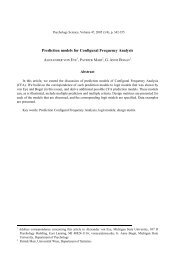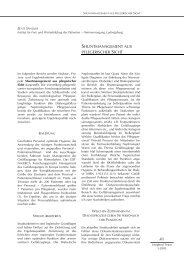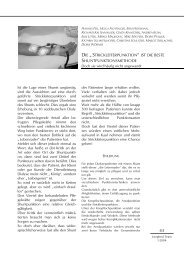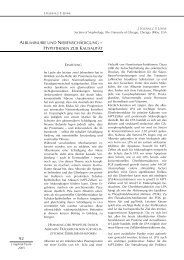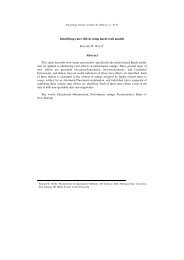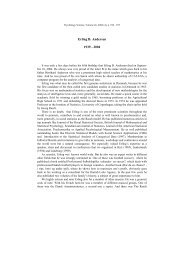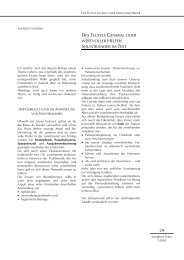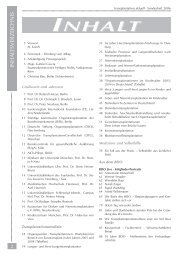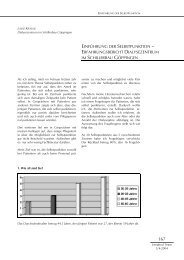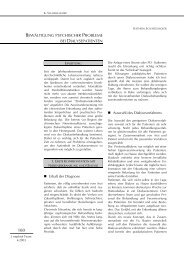Download PDF of the full article - Pabst Science Publishers
Download PDF of the full article - Pabst Science Publishers
Download PDF of the full article - Pabst Science Publishers
You also want an ePaper? Increase the reach of your titles
YUMPU automatically turns print PDFs into web optimized ePapers that Google loves.
202 T. Kováč<br />
Besides this, we also administered <strong>the</strong> School Stressors Inventory for Adolescents (SSIA)<br />
by J. P. Fanshav and P. C. Burneth in <strong>the</strong> Slovak adaptation by I. Sarmány Schuller. It focuses<br />
on coping with various qualities <strong>of</strong> stressors that occur in a school setting.<br />
O<strong>the</strong>r variables were <strong>the</strong> age <strong>of</strong> <strong>the</strong> subjects, <strong>the</strong>ir average school achievement, and<br />
evaluation by <strong>the</strong>ir soccer instructors. The instructors devided <strong>the</strong> boys in three performance<br />
categories and mark 1 represented <strong>the</strong> best performance.<br />
59 boys altoge<strong>the</strong>r participated in <strong>the</strong> research from 1 st , 2 nd and 3 rd grades <strong>of</strong> <strong>the</strong> school<br />
aged 14 to 17 years.<br />
The data obtained underwent a statistical analysis by <strong>the</strong> method <strong>of</strong> Rotating Factor<br />
Analysis – Varimax (Koschim et al., 1992). The number <strong>of</strong> factors that should be extracted by<br />
rotation was addressed by <strong>the</strong> so-called Ludwig`s Criterion (Jahn & Vahle, 1970).<br />
The factor analysis in <strong>the</strong> Statgraphics Program titrated two factors. Toge<strong>the</strong>r with<br />
saturating <strong>the</strong> particular variables, <strong>the</strong>y are presented in Table 1. As we can see, <strong>the</strong> fi rst<br />
factor is most saturated by creativity variables. Therefore, it is logical, that we called it – <strong>the</strong><br />
Factor <strong>of</strong> creativity. In <strong>the</strong> negative relation with creativity we can see a putative position<br />
<strong>of</strong> <strong>the</strong> variables <strong>of</strong> school achievement and soccer effi ciency. However, <strong>the</strong> negative sign is<br />
based upon <strong>the</strong> fact that school achievement as well as soccer effi ciency were evaluated on <strong>the</strong><br />
scale where number 1 represented <strong>the</strong> best performance. From this it is clear that better school<br />
marks and performances on <strong>the</strong> playground went hand in hand with growing creativity. The<br />
above-mentioned fi nding is nontraditional to a certain extent because <strong>the</strong> data from literature<br />
tend to contradict (T. Kováč, 1980; Zelina & Zelinová, 1990). This means that combining<br />
school education with active sports activity enables creative individuals to develop <strong>the</strong>ir<br />
talent more effectively and vice versa. This also underlines <strong>the</strong> fact that coping with stress<br />
is in negative relationship with creativity (here applies: <strong>the</strong> higher scores, <strong>the</strong> worse coping<br />
with stress). The second factor is mostly saturated by variables <strong>of</strong> creative memory, coping<br />
with stress, performances in soccer, and age. Since all above-listed variables are in a positive<br />
relationship, this factor can presumably be called a barrier memory. The better <strong>the</strong> memory <strong>of</strong><br />
<strong>the</strong> subjects, <strong>the</strong> worse <strong>the</strong>ir coping with stressors as well as soccer effi ciency. We can assume<br />
that when subjects remember failures, this negatively infl uences <strong>the</strong>ir perception <strong>of</strong> school<br />
stress and functioning <strong>of</strong> a player on <strong>the</strong> fi eld – it shakes his self-confi dence. Since older boys<br />
did “experience” more in both areas, <strong>the</strong> coherence with age is easier to understand. The weak<br />
saturation by creativity variables and achievement prove that stronger negative experiences<br />
infl uence soccer talent more signifi cantly. This fi ndings can be a warning for all those who<br />
work with talents <strong>of</strong> this kind to apply a method <strong>of</strong> praises in a wider extent.<br />
In conclusion we can assume that:<br />
1. Creativity is a distinct feature <strong>of</strong> soccer talent<br />
2. Creativity makes it easier to cope with stress<br />
3. Negative experiences in <strong>the</strong> given area inhibit <strong>the</strong> development <strong>of</strong> a soccer talent<br />
The results <strong>of</strong> this research are considered to be preliminary. To have a wider platform,<br />
a control group would be necessary, and, <strong>of</strong> course, <strong>the</strong> expansion <strong>of</strong> <strong>the</strong> set <strong>of</strong> research<br />
methods (personality, cognitive styles). Never<strong>the</strong>less, we think that we pointed in <strong>the</strong> direction<br />
where <strong>the</strong> development <strong>of</strong> talents could go. Teaching at our secondary schools is too saturated<br />
with high intensity and <strong>the</strong> absence <strong>of</strong> developing creative thinking. In such a condition, many<br />
talents evade, i. e. resign. The goal <strong>of</strong> all interested parties should be to interlude this elusion.



